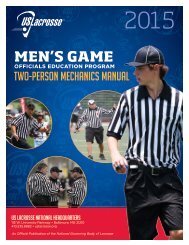BASKETBALL
You also want an ePaper? Increase the reach of your titles
YUMPU automatically turns print PDFs into web optimized ePapers that Google loves.
Rule 9 / Violations and Penalties83<br />
Art. 2. A shot-clock try for field goal is defined as the ball having left the<br />
shooter’s hand(s) before the sounding of the shot-clock horn and then striking the<br />
ring or flange, or entering the basket.<br />
Art. 3. The team in control must attempt a try as in 9-12.2 for field goal within<br />
35 seconds after the shot clock period begins.<br />
Art. 4. It is a violation when a try for field goal does not leave the shooter’s hand<br />
before the expiration of the allotted shot-clock time (as indicated by the sounding<br />
of the shot-clock horn) or when it does leave the shooter’s hand before the<br />
expiration of the alotted shot-clock time and the try does not subsequently strike<br />
the ring or flange or enter the basket.<br />
Section 13. Back Court<br />
Art. 1. A team’s front court shall consist of that part of the playing court between<br />
its end line and the nearer edge of the division line, including its basket and the<br />
inbounds part of its backboard.<br />
Art. 2. A team’s back court consists of the rest of the playing court, including<br />
its opponent’s basket and inbounds part of the backboard and the division line,<br />
excluding the mathematical edge nearest the team’s basket.<br />
Art. 3. A live ball is in the front court or back court of the team in control as<br />
follows:<br />
a. A ball that is in contact with a player or with the playing court shall be in<br />
the back court when either the ball or the player (either player when the<br />
ball is touching more than one) is touching the back court. It shall be in the<br />
front court when neither the ball nor the player is touching the back court.<br />
b. A ball that is not in contact with a player or the playing court retains the<br />
same status as when it was last in contact with a player or the playing<br />
court.<br />
c. During a dribble from back court to front court, the ball shall be in the<br />
front court when both feet of the dribbler and the ball touch the playing<br />
court entirely in the front court.<br />
Art. 4. A player shall not be the first to touch the ball in his back court (with any<br />
part of his body, voluntarily or involuntarily) when the ball came from the front<br />
court while that player’s team was in team control and that player or his teammate<br />
was the last to touch the ball before it went into the back court.<br />
Art. 5. A pass in the front court that is deflected by a defensive player so that the<br />
ball goes into the back court may be recovered by either team.<br />
Art. 6. Regardless of where the throw-in spot is located, the throw-in team may<br />
cause the ball to go into the back court before player control has been established<br />
by the throw-in team on the playing court.<br />
Art. 7. After the throw-in ends, an inbounds player in the front court, who is not<br />
in control of the ball, may cause the ball to go into the back court.<br />
Art. 8. A player who is the first to secure control of the ball in the front court<br />
after a jump ball or a throw-in while both feet are off the playing court shall not<br />
be permitted to cause the ball to go into the back court, except as permitted in<br />
Rule 9-13.10.




